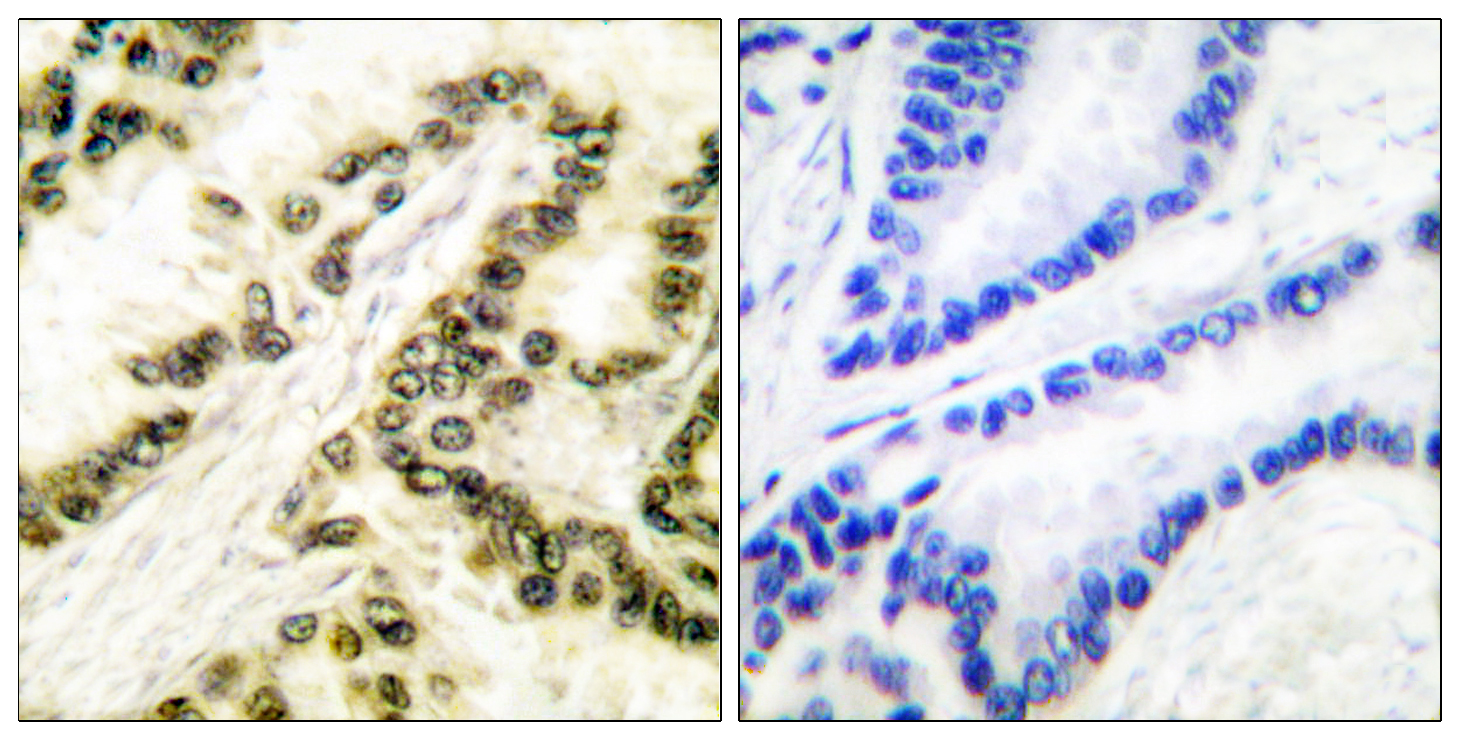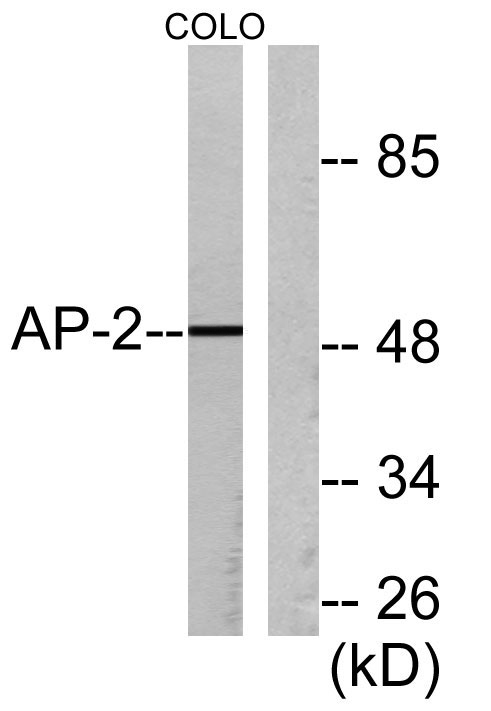AP-2α/β Polyclonal Antibody
- Catalog No.:YT0253
- Applications:WB;IHC;IF;ELISA
- Reactivity:Human;Mouse;Rat
- Target:
- AP-2α/β
- Gene Name:
- TFAP2A/TFAP2B
- Protein Name:
- Transcription factor AP-2-alpha/beta
- Human Gene Id:
- 7020
- Human Swiss Prot No:
- P05549/Q92481
- Mouse Gene Id:
- 21418/21419
- Rat Swiss Prot No:
- P58197
- Immunogen:
- The antiserum was produced against synthesized peptide derived from human AP-2. AA range:388-437
- Specificity:
- AP-2α/β Polyclonal Antibody detects endogenous levels of AP-2α/β protein.
- Formulation:
- Liquid in PBS containing 50% glycerol, 0.5% BSA and 0.02% sodium azide.
- Source:
- Polyclonal, Rabbit,IgG
- Dilution:
- WB 1:500 - 1:2000. IHC 1:100 - 1:300. ELISA: 1:10000.. IF 1:50-200
- Purification:
- The antibody was affinity-purified from rabbit antiserum by affinity-chromatography using epitope-specific immunogen.
- Concentration:
- 1 mg/ml
- Storage Stability:
- -15°C to -25°C/1 year(Do not lower than -25°C)
- Other Name:
- TFAP2A;AP2TF;TFAP2;Transcription factor AP-2-alpha;AP2-alpha;AP-2 transcription factor;Activating enhancer-binding protein 2-alpha;Activator protein 2;AP-2;TFAP2B;Transcription factor AP-2-beta;AP2-beta;Activating enhancer-bindi
- Observed Band(KD):
- 49kD
- Background:
- transcription factor AP-2 alpha(TFAP2A) Homo sapiens The protein encoded by this gene is a transcription factor that binds the consensus sequence 5'-GCCNNNGGC-3'. The encoded protein functions as either a homodimer or as a heterodimer with similar family members. This protein activates the transcription of some genes while inhibiting the transcription of others. Defects in this gene are a cause of branchiooculofacial syndrome (BOFS). Three transcript variants encoding different isoforms have been found for this gene.[provided by RefSeq, Dec 2009],
- Function:
- alternative products:Experimental confirmation may be lacking for some isoforms,disease:Defects in TFAP2A are the cause of branchiooculofacial syndrome (BOFS) [MIM:113620]; also known as branchial clefts with characteristic facies, growth retardation, imperforate nasolacrimal duct, and premature aging or lip pseudocleft-hemangiomatous branchial cyst syndrome. BOFS is a rare autosomal dominant cleft palate craniofacial disorder with variable expressivity. The major features include cutaneous anomalies, ocular anomalies, characteristic facial appearance (malformed pinnae, oral clefts), and, less commonly, renal and ectodermal (dental and hair) anomalies.,domain:The WW-binding motif mediates interaction with WWOX.,function:Sequence-specific DNA-binding protein that interacts with inducible viral and cellular enhancer elements to regulate transcription of selected genes. AP-2 factors bind to
- Subcellular Location:
- Nucleus .
- Expression:
- Prostate,Teratocarcinoma,
- June 19-2018
- WESTERN IMMUNOBLOTTING PROTOCOL
- June 19-2018
- IMMUNOHISTOCHEMISTRY-PARAFFIN PROTOCOL
- June 19-2018
- IMMUNOFLUORESCENCE PROTOCOL
- September 08-2020
- FLOW-CYTOMEYRT-PROTOCOL
- May 20-2022
- Cell-Based ELISA│解您多样本WB检测之困扰
- July 13-2018
- CELL-BASED-ELISA-PROTOCOL-FOR-ACETYL-PROTEIN
- July 13-2018
- CELL-BASED-ELISA-PROTOCOL-FOR-PHOSPHO-PROTEIN
- July 13-2018
- Antibody-FAQs
- Products Images

- Western Blot analysis of various cells using AP-2α/β Polyclonal Antibody cells nucleus extracted by Minute TM Cytoplasmic and Nuclear Fractionation kit (SC-003,Inventbiotech,MN,USA).

- Immunohistochemistry analysis of paraffin-embedded human lung carcinoma tissue, using AP-2 Antibody. The picture on the right is blocked with the synthesized peptide.

- Western blot analysis of lysates from COLO205 cells, using AP-2 Antibody. The lane on the right is blocked with the synthesized peptide.



